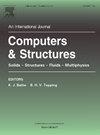基于梯度增强Kriging模型的加速哈密顿蒙特卡罗贝叶斯更新
IF 4.4
2区 工程技术
Q1 COMPUTER SCIENCE, INTERDISCIPLINARY APPLICATIONS
引用次数: 0
摘要
贝叶斯方法已被广泛应用于土木工程中,以提高有限元模型的精度。然而,贝叶斯方法在准确识别后验分布时通常存在计算复杂度的问题。为了解决这一问题,本文提出了一种将哈密顿蒙特卡罗(HMC)算法与梯度增强克里金(GEK)模型相结合的新方法,称为HMC-GEK,以提高模型更新的效率。该方法利用HMC燃烧阶段产生的势函数和梯度信息来训练GEK模型。通过用GEK模型代替高成本势能函数,加快了原始HMC采样过程。以一个八层框架结构和一座y形拱桥为例,验证了该方法的准确性和有效性。采用HMC-GEK方法对实际八层钢框架结构进行损伤识别。与传统Kriging模型的HMC方法相比,HMC- gek更充分地利用了势函数的梯度信息,显著提高了样本接受率和计算效率。此外,该方法在实际结构损伤识别中的成功应用证明了其在工程上的应用价值。本文章由计算机程序翻译,如有差异,请以英文原文为准。
Bayesian updating using accelerated Hamiltonian Monte Carlo with gradient-enhanced Kriging model
Bayesian methods have been widely used to improve the accuracy of finite element model in civil engineering. However, Bayesian methods generally suffer from the computational complexity involved in accurately identifying the posterior distribution. To address this issue, this paper proposes a novel method by combining the Hamiltonian Monte Carlo (HMC) algorithm with the gradient-enhanced Kriging (GEK) model, termed HMC-GEK, for more efficient model updating. The proposed method uses the potential function and gradient information generated during the burn-in phase of the HMC to train the GEK model. By replacing high-cost potential function with the GEK model, the original HMC sampling process is accelerated. An eight-story frame structure and a Y-shaped arch bridge are used to validate the accuracy and efficiency of the proposed method. Furthermore, the HMC-GEK method has been employed to identify damage of a real eight-story steel frame structure. Compared with the HMC method with the traditional Kriging model, HMC-GEK makes more full use of the gradient information of the potential function and significantly improves the sample acceptance rate and computational efficiency. In addition, the successful application of the method in damage identification of the real structure demonstrates its value for engineering applications.
求助全文
通过发布文献求助,成功后即可免费获取论文全文。
去求助
来源期刊

Computers & Structures
工程技术-工程:土木
CiteScore
8.80
自引率
6.40%
发文量
122
审稿时长
33 days
期刊介绍:
Computers & Structures publishes advances in the development and use of computational methods for the solution of problems in engineering and the sciences. The range of appropriate contributions is wide, and includes papers on establishing appropriate mathematical models and their numerical solution in all areas of mechanics. The journal also includes articles that present a substantial review of a field in the topics of the journal.
 求助内容:
求助内容: 应助结果提醒方式:
应助结果提醒方式:


